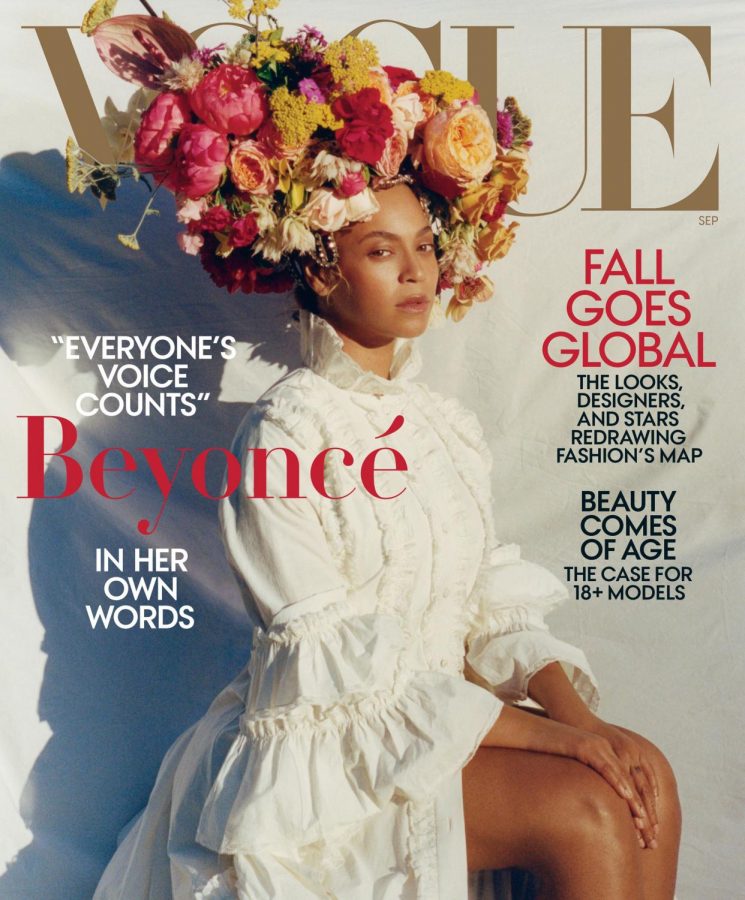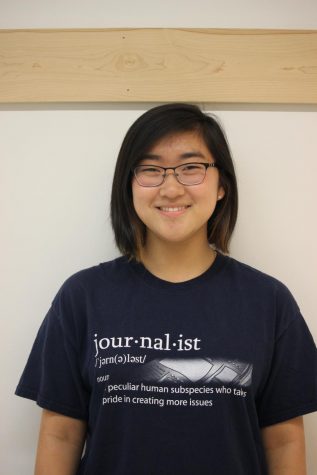Vogue September Issue embraces social change
January 27, 2019
Her eyes seem to follow you as you move around her. In a true Victorian, Mona Lisa-esque fashion, Beyonce sits in the center of the cover wearing a tiered, billowing, pristinely white Gucci dress, coyly unbuttoned as it meets her legs and boldly contrasting her skin. Her neck, holding up her headpiece, heavy with warm, blooming flowers, refuses to acknowledge the weight — and Beyonce sits still, with piercing eyes and a slight smile that disappears if you look long enough.
The minimalism of her dress against a plain white curtain highlights her face – the face of a strong, self-made woman of color- and foreshadows of the theme of color in the cover story inside.
In addition to its inclusion of the woman who has built her reputation as one of the current commanders of the music industry, this issue is rumoured to be Anna Wintour’s last. And while we couldn’t find damning evidence that that’s the case, it still warranted a special look at the iconic September issue that marks the fashion world’s shift to autumn.
The issue doesn’t actually begin until page 138, with the first 137 pages being home to a slew of glossy fashion ads and editorials tributing the strata of beautiful people whose opulent wealth high fashion seems to revolve about. When the table of contents (finally) appears, however, it seems to point to Vogue trying to separate themselves from that narrative. Stories about two self-made women of color, Beyoncé and Tiffany Haddish, immediately jump out at the reader. So does a story on refugees in the culinary world and the perils of underage models.
Then it’s back to the ads, and the faces of the attractive, the famous, the wealthy.
Along the way, we meet the prodigious photographer Tyler Mitchell, who describes his photography style as concerned and his purpose as un-thingifying the black community. Perhaps it was this inspired freshness that led Beyoncé to choose Tyler as her photographer, making them both novel forces in the Vogue world, especially with Tyler being the first African American photographer to shoot a Vogue cover. It is curious that Tyler is mentioned before anyone else in the issue, but perhaps introducing the issue from such an agent of youth is telling of Vogue’s efforts to align themselves with them.
But still adhering to tradition, following is the ever-present statement from the ultimate arbitrator of style, Anna Wintour. Opening with her characteristic flair, Anna effectively forbids the idea of a fashion ‘trend,’ instead saying that in a rapidly radicalizing world, fashion must follow suit. She thus introduces this September issue as one to shatter the tenets of traditional fashion ideals.
Having done the obligatory flip through of the first few fashion spreads- so far, Stella McCartney displays environment friendly, yet consciously elaborate dresses and Tom Ford forays into luxe streetwear- and whiffed the sharp scents of the muddled perfumes, we turn the page to the Beyoncé story. It is, after all, the main attraction.
For a cover story, however, it’s surprising to find that it’s neither a story nor very long. Beyonce’s untempered words lack the eloquence of a professional writer but give the read some much needed authenticity amid all the filters. Her humility, starkly apparent against the backdrop of her golden fame, makes for a personal, sensitive read. Beyoncé is gentle, then fierce, altering her tone to the invisible questions she both asks and answers. On opening doors, Beyoncé thanks the women of color before her who allowed her to achieve her success and prays that she can do the same for a coming generation. She acknowledges the circulation of power between powerful and affluent circles and takes it as her duty to bring in diversity in spite of finding herself a part of those privileged circles. Laced explicitly in the entire story is Beyoncé’s deep commitment to her color; she unabashedly accepts her natural body, face, hair and skin through her words and the accompanying shoot.
In what first seems like a provocative position- legs wide open and angled towards the reader, upper thighs showing- Beyoncé’s insouciant expression proves otherwise. Her eyes dare the reader, throw out an invisible challenge. She’s not smiling in a single shot.
Vogue takes this thread of embracing color and weaves it throughout the entire issue; a fashion spread centered about an amorphous gele and a photo profile of two alternative Muslim activists are particularly refreshing. Other articles, such as a bittersweet read on refugees finding a haven in the culinary scene and a review of the maestros of fashion today- Karl Lagerfeld, Nicolas Ghesquiére- also fit well into Vogue’s chicly aware personality.
The true star of the issue, however, is not the cover star, but Tiffany Haddish. Set against Beyoncé’s inherent mystique, Haddish’s frankness is edgy and real. The profile digs beneath Haddish’s blunt demeanor to reveal a complicated childhood during which Haddish was subject to abuse by her mentally ill mother and the absence of her Eritrean father; this resulted in her being shunted into the foster system. After failing to read beyond the first grade level well into elementary school, Haddish was recommended comedy as therapy and it soon became her passion. Now looking back on her troubled childhood, Haddish soberly describes her efforts to help other kids in the same position as she once was.
This September issue has proven Vogue’s affinity for provocative stories. To some extent, it pushes the limitations of what a fashion magazine is supposed to be – save for the distinctive, story-telling fashion photography that comes with the stories. Vogue has somehow intertwined the world of luxury fashion into the movement of culture.
This shift to social issues is not an unprecedented move on Vogue’s part. The connection between society and beauty, with its aesthetic but classist results and the heated criticisms that inevitably follow have become so prevalent that Vogue Magazine itself has picked up on these conversations as a significant topic of interest. One can’t help but pick up on an ironic feeling between reading about Beyonce’s own body acceptance and the burnout of underage models, while staining our fingers with perfumes upward of $50 and looking at an extended page of Versace models dressed somehow glamorously and messily with the same heights and shapes.
Vogue hasn’t lost touch with their disciplined coverage of the fashion industry and the newest on-trend item, and there is little doubt in our minds that Vogue will remain the upstanding magazine for fashion for many, many, many years to come. Somehow, Vogue’s status as a predominantly high fashion, luxury magazine, often setting the standard for what is deemed beautiful and on trend, does not disqualify the messages they tell with their socially motivated stories. Vogue is heading towards is an era of self-criticism —
And it’ll be interesting to see how Vogue uses its platform in correspondence to social breakthrough.



